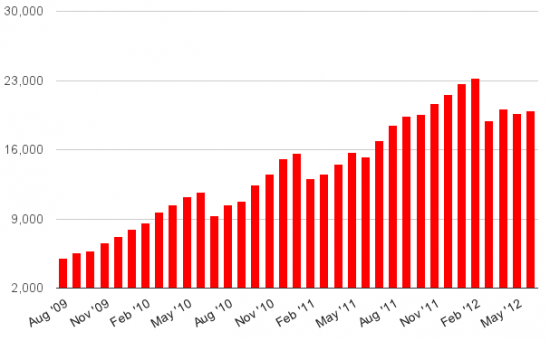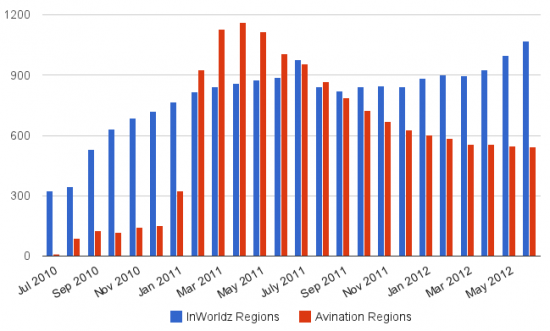The top 40 OpenSim grids reported a total of 19,926 regions this month, up slightly from last month’s 19,668 regions — despite another round of housekeeping on OSGrid.
OSGrid, the largest grid on the OpenSim platform, dropped from more than 9,000 regions earlier this week to under 7,000. According to OSGrid president Michael Cerquoni, the grid cleaned up its map, removing 2,507 unused region reservations.

However, the total number of active 30-day users on the top 40 grids dropped by 2,127 this month, from 18,518 last month to 16,391 today.
Grid owners attributed the drop in traffic to two major factors — the end of the academic school year, and the improved stability on the Second Life grid.
“It relates to students already completing the educational virtual world activities they had gone inworld to do,” Kitely CEO Ilan Tocher told Hypergrid Business. “I don’t know if I would categorize that as seasonal, we’ll have to wait until school starts again to see whether it was. The important thing for us is that we are seeing new educational projects beginning as well.”
Meanwhile, last month, Second Life went down for long periods of time, sending some users out to explore OpenSim. OSGrid, for example, had around 500 more active users last month. InWorldz had almost 600 more active users, and Avination saw a drop of over 300 users from last month to this month.
“You can see the effect outages on ‘the big grid’ have on our numbers comparing this month and last month,” InWorldz CTOÂ David Daeschler told Hypergrid Business.
We have 171 active grids in our directory this month, up from 154 grids a month ago.
Busy grids
Here are the ten most active grids this month:
- InWorldz:Â 5,831 active 30-day users
- OSGrid:Â 3,738
- Avination:Â 2,427
- FrancoGrid:Â 753
- ReactionGrid:Â 425
- Island Oasis:Â 417
- 3rd Rock Grid:Â 357
- German Grid:Â 253
- Kitely:Â 240
- JokaydiaGrid:Â 200
Out of curiosity, I ran a quick density calculation — how many active users did each grid have per region? I wasn’t surprised that educational grids, including UoBGrid, PLANE, and Espurnik, dominated the top five, since classroom instruction requires large numbers of users together in one location. I was surprised to see large grids like InWorldz and ReactionGrid in the top ten.
OSGrid, with many free, home-hosted regions, placed 62 in our list. Kitely, with its on-demand business model, was number 99.
Note that this calculation doesn’t reflect the likelihood of finding users on any given region, since there’s no way to know how much time each active user spent in-world. Today, no grid releases the total number of hours users spent in-world. Though that would be a great stat to have.
The twenty densest grids:
- UoBGrid: 23.7 active users per region, 3 regions
- PLANE: 11 active users per region, 7 regions
- DigiGrids: 9.9 active users per region, 7 regions
- Espurnik: 7.4 active users per region, 19 regions
- Island Oasis: 5.5 active users per region, 76 regions
- InWorldz: 5.5 active users per region, 1,068 regions
- ReactionGrid: 5.4 active users per region, 78 regions
- EnglishGrid: 5.3 active users per region, 12 regions
- Misfits Folly: 5 active users per region, 2 regions
- Viradu: 4.6 active users per region, 12 regions
- Avination: 4.5 active users per region, 542 regions
- linkinulife: 4.4 active users per region, 35 regions
- Talon Grid: 3.8 active users per region, 4 regions
- Pathlandia: 3.5 active users per region, 4 regions
- German Grid: 3.3 active users per region, 76 regions
- Haven: 2.9 active users per region, 12 regions
- Iti Motu Resort: 2.7 active users per region, 6 regions
- JokaydiaGrid: 2.4 active users per region, 85 regions
- Oneworld Grid: 2.2 active users per region, 6 regions
- Contepomi: 2 active users per region, 3 regions
There were a total of 7,193 active 30-day users on the 81 hypergrid-enabled grids that reported their numbers this month. However, this does not mean that there are 7,193Â different people on the hypergrid, since some people have multiple accounts. In addition, when a user of one grid makes a hypergrid teleport to another grid, they are sometimes counted in the active user numbers on both grids.
While most large grids only count local residents when tracking active 30-day user numbers, many smaller grids also count in hypergrid visitors because these external visits make up the bulk of the traffic on their grids.
For example, out of 91 unique visitors this month to the Belgian Speculoos grid, only 19 were locally registered residents. The grid has become a favorite destination for users of other small grids looking for freebie items, because it is the home of Linda Kellie’s Freebie Mall. The Mall is the largest single collection of Creative Commons-licensed content in OpenSim, available for use by anyone for any purpose, including commercial. Grid owners can download their own copy of the Freebie Mall OAR region file here.
Similarly, on John Lester’s Pathlandia grid, there were a total of three registered users on the grid — and 14 different visitors last month. Which makes sense, since Lester, who works for ReactionGrid, is also the founder of the Hypergrid Adventurers Club.
Another grid with more visitors than residents is Sanctuary, which is home to a collection of hypergates that go to other worlds. It had 36 visitors last month, and seven registered residents.
FleepGrid is also popular with hypergrid visitors because of its Creative Commons-licensed, educator-friendly freebie stores. There were 44 hypergrid visitors in the month of May, said grid owner Chris Collins, who works at the Center for Simulations and Virtual Environments Research at the University of Cincinnati. By comparison, there were only 13 visitors who had locally registered avatars. According to Collins, visitors have snapped up a total of 2,358 freebie items so far this year — compared to just 2,144 in all of 2011.
Land gains
Kitely was the biggest land gainer again this month, with 108 new regions, bringing the total number of regions on the on-demand grid to 1,938.

“We rolled out several frequently requested features this month,” said Kitely’s Tochner. “Intelligently replacing existing worlds with new OAR files, automatically disconnecting idle users, sending IMs to world managers directly from the website, and using Kitely Credits as a virtual currency — with transaction tracking in the History page.”
In-world payments is likely to increase usage further, he added.
“We’re seeing initial signs of content developers working to bring their premium content over to Kitely to take advantage of the large amount of KC people have already accumulated since we started selling them in February,” he said. “Up next, we’ll be enabling people to pay for premium plans using just KC, so successful merchants will be able to have multiple regions on Kitely without having to spend a dime out of pocket. We’ll also be rolling out various options for people to automatically charge or give other people KC when they visit their worlds. Finally we’ll be providing a way for people who run registered exchanges to run their business with reduced fraud risk.”
In addition, Kitely will soon be offering megaregions for users on premium plans, so expect to the see the number of regions jump significantly. At Hypergrid Business, we count land area in terms of standard region equivalents, so a basic megaregion would count as four standard regions.
InWorldz gained 69 regions, for a new peak of 1,068 regions. Speculoos gained 46 regions, almost doubling the size of the grid, to a new high of 105 regions. Other grids gained 30 regions each or less.
Avination continued to drop in size, losing seven regions this month, for a new total of 542 regions.

Transitions
The education-focused Second Learning grid has merged with 3D Grid and will be moving forward under the 3D Grid name, as part of the transition from an experimental project to a more permanent, professional platform.
“Last but not least, the proximity of the name ‘Second Learning’ to ‘Second Life’ is no longer required, since we clearly differentiate ourselves from Second Life with our services and our grid,” said grid manager Markus Metzmacher in an announcement.
The Second Learning grid was used primarily by Germany’s University of Auksberg, with 14 virtual projects conducted so far. More information about the university’s use of OpenSim is at edu.3dworld.de.
Some examples:
- The Virtual University of Augsburg , where new students could familiarize themselves with the university’s layout.
- AÂ project management facility to support group-oriented project work.
- The Alchemist’s Castle, where students studied chemical principles in a playful environment.
-  The walk-in computer, where students could walk around the CPU, RAM and hard drive and other inner parts of a computer.
- A first aid course which conveyed the basics of first aid for as part of an adventure set in ancient Greece.
- A space camp where students underwent virtual astronaut training.
- A driving school in which students prepared virtually for the written portion of the driver’s test.
- An office building used to test emergency exit planning.
New grids
This month, we’ve added several new grids to our database, including Siberspace, AIRE Mille Flux, Pandora, Misfits Folly, Startup World, Ocean Grid, VWNFL, Witchville, Talon Grid, EasilyDone, Rockcliffe, Genesis Project, Shangri-La Grid, Hippy Grid, Espurnik, The Loom, and OpenSim Creations. Of these, only Genesis Project was big enough to make our top-40 list.
If there’s a public grid we’re not tracking, please email us at editor@hypergridbusiness.com. There’s no centralized way to find OpenSim grids, so if you don’t tell us about it, and Google doesn’t alert us, we won’t know about it.
Well, there is one centralized way to find some grids — the New World Studio grid directory. It currently lists 430 different worlds, totaling 3,619 regions. There are many duplicates on this list, however, and few worlds were up when we checked. Those that were up, didn’t load for us. This could be because the software is still new and most people are still testing it out, or because of router configuration issues. The New World Studio is a fantastic way to get OpenSim up and running on a home computer, but making these worlds accessible to the public isn’t always as easy.
However, there are also statistics for one popular version of OpenSim, the Diva Distro, a four-region, hypergrid-enabled, pre-configured minigrid.
The Diva Distro has been downloaded 733 times over the past month. The total number of Diva Distro downloads now stands at 14,695. This does not mean that there are thirteen thousand mini-grids out there, however — someone might download the software but never use it, or download it once and use it to set up many grids. And it doesn’t include the Diva Distros used as part of the popular, and super-easy, New World Studio distribution of OpenSim.
Diva Distro is also part of Sim-on-a-Stick, a version of OpenSim packaged to run on a USB stick. According to Sim-on-a-Stick creator Ener Hax, the USB-friendly OpenSim package has been downloaded 681 times over the past month, bringing the total of these downloads to 11,963.
Meanwhile, according to data from The Hypergates, the number of hypergrid travelers increased by just 4 travelers, to 4,461, compared to the previous month. The Hypergates regularly updates the list of travelers, and if the gates to a particular grid is taken down, the users from that grid are removed from the totals. The total jumps made dropped to 2,979 from last month’s 3,116, and there were a total of 58 grids on the network, up by 19 from last month. The drop in jumps could be a result of database issues on the network, or the fact that more people are making hypergrid jumps by other means.
For example, not all hypergates are part of The Hypergates network — anyone can create their own hypergrid by dropping a script on any object, such as our touch or walk-through single-destination hypergate script. In addition, many people do hypergrid jumps without using any gate at all, simply by typing a hypergrid address into Map-Search. There is currently no way of tracking that traffic.
In addition, after someone has made a hypergrid jump to an interesting destination, they can make a landmark of that destination and come back anytime without using a gate.
Our own Hyperica directory now tracks 97 grids that are accessible via hypergrid, up from 88 last month. This past month also saw 128 unique visitors to the Hyperica in-world hypergate terminals, up from 124 the previous month.
Meanwhile, Second Life lost 23 regions this past month, according to data from Grid Survey. Second Life now has a total of 29,945 regions, a decline of 1,295 regions from this time last year, and a drop of 1,940 regions from its peak in June 2010. Second Life no longer reports active user numbers.
June Region Counts on the Top 40 Grids
We are now tracking a total of 313 different publicly-accessible grids, 171 of which were active this month, and 140 of which published their statistics. Many smaller school, company or individual grids do not publish their numbers, and neither do SpotOn3D and OpenLifeGrid.
The raw data for this month’s report is here. A list of all active grids is here.
- OSGrid: 6,944 regions
- ScienceSim: 2,520 regions
- Kitely: 1,938 regions
- InWorldz: 1068 regions
- Virtual Worlds Grid: 935 regions
- Metropolis: 715 regions
- The Other Universe: 714 regions
- FrancoGrid: 546 regions
- Avination: 542 regions
- MyOpenGrid: 488 regions
- MyOpenGrid: 488 regions
- Lost Paradise: 266 regions
- Neuland: 224 regions
- 3rd Rock Grid: 205 regions
- Moses: 182 regions
- GridNirvana: 176 regions
- Virtyou: 132 regions
- Craft World: 131 regions
- Logicamp: 114 regions
- Speculoos: 105 regions
- Virtual Highway: 105 regions
- Gay Nations: 104 regions
- Infinite Grid: 99 regions
- OpenSim.ru: 94 regions
- SimValley: 90 regions
- JokaydiaGrid: 85 regions
- eceCloud: 84 regions
- ReactionGrid: 78 regions
- German Grid: 76 regions
- Island Oasis: 76 regions
- PMGrid: 76 regions
- GerGrid: 75 regions
- Savage Grid: 74 regions
- Altera Vita: 65 regions
- Dorena’s World: 61 regions
- YourSimSpot: 57 regions
- Icarus Realms: 50 regions
- TUIS Open Grid: 50 regions
- Genesis Project: 49 regions
- Tertiary Grid: 45 regions
- OSgrid back online after extended maintenance - April 16, 2025
- Analysts predict drop in headset sales this year - March 25, 2025
- OSgrid enters immediate long-term maintenance - March 5, 2025
